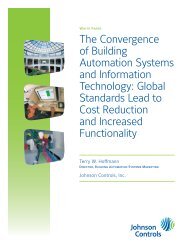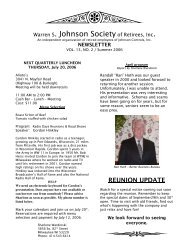Generation Y and the Workplace Annual Report 2010 - Haworth
Generation Y and the Workplace Annual Report 2010 - Haworth
Generation Y and the Workplace Annual Report 2010 - Haworth
You also want an ePaper? Increase the reach of your titles
YUMPU automatically turns print PDFs into web optimized ePapers that Google loves.
78<br />
Global WorkPlace Innovation<br />
Photographer: Oriane Pesquier<br />
Emotional Engagement<br />
Emotional engagements is elusive <strong>and</strong> no<br />
wonder since it encompasses strength of feeling<br />
towards work, our colleagues <strong>and</strong> our physical<br />
surroundings, all of which interact in non-simple<br />
ways. Achieving emotional engagement is <strong>the</strong><br />
holy grail of workplace design in <strong>the</strong> emerging<br />
innovation age, where knowledge is created <strong>and</strong><br />
shared through networks. Underst<strong>and</strong>ing how<br />
people work <strong>and</strong> socialise in networks, <strong>and</strong> how<br />
<strong>the</strong>ir workplace environments help or hinder <strong>the</strong>m,<br />
is now fundamental <strong>and</strong> urgent.<br />
Emotional engagement is an outcome of <strong>the</strong><br />
strength of feeling we have towards work, our<br />
colleagues <strong>and</strong> our physical surroundings, all of<br />
which interact in non-simple ways. It is influenced<br />
by having <strong>the</strong> opportunity, desire <strong>and</strong> <strong>the</strong> right<br />
sort of environments, which allow us to connect<br />
with work <strong>and</strong> each o<strong>the</strong>r 49 . Achieving emotional<br />
engagement is <strong>the</strong> holy grail of workplace design<br />
in <strong>the</strong> emerging innovation age, where knowledge<br />
is created <strong>and</strong> shared through networks.<br />
Underst<strong>and</strong>ing how people work <strong>and</strong> socialise in<br />
networks, <strong>and</strong> how <strong>the</strong>ir workplace environments<br />
help or hinder <strong>the</strong>m, is now fundamental <strong>and</strong> urgent.<br />
An overwhelming amount has been written about<br />
how to influence intrinsic motivation, a close<br />
relative of emotional engagement, by focusing on<br />
combinations of social relationships, technology,<br />
job design <strong>and</strong> business processes. The role<br />
of <strong>the</strong> workplace is rarely considered. That is<br />
changing rapidly. The workplace is taking centrestage<br />
as people come toge<strong>the</strong>r to socialise,<br />
collaborate <strong>and</strong> learn. We also need space for<br />
isolation <strong>and</strong> contemplation.<br />
Copyright © <strong>2010</strong>, Johnson Controls. Confidential. All Rights Reserved.<br />
Intellectual Property Johnson Controls, <strong>Haworth</strong> <strong>and</strong> iDEA.<br />
“Engagement is about creating<br />
opportunities for employees to connect<br />
with <strong>the</strong>ir colleagues, managers<br />
<strong>and</strong> wider organisation. It is also<br />
about creating an environment where<br />
employees are motivated to want to<br />
connect with <strong>the</strong>ir work <strong>and</strong> really<br />
care about doing a good job.” 48<br />
Enterprises are fragmenting into eco-systems<br />
of partnerships <strong>and</strong> nomadic work-on-<strong>the</strong>-go is<br />
normal. Consequently workplaces are <strong>the</strong>mselves<br />
transforming, kaleidoscope-like, into patterns<br />
of distributed <strong>and</strong> virtual configurations. The<br />
plethora of public spaces available through wifi<br />
allows permanently connected knowledge workers<br />
choice in where <strong>the</strong>y work based on what mood<br />
<strong>the</strong>y are in, what <strong>the</strong>y have to do <strong>and</strong> who <strong>the</strong>y<br />
have to be with. This self-determination satisfies<br />
<strong>the</strong>ir emotional needs.<br />
“It is becoming commonplace for a cafe to be<br />
full of people ... more engaged with <strong>the</strong>ir in-box<br />
than with <strong>the</strong> people touching <strong>the</strong>ir elbows. These<br />
places are physically inhabited but psychologically<br />
evacuated ”<br />
The Economist 50 .<br />
It is conceivable that <strong>the</strong>re might come a day when<br />
offices are no longer considered necessary <strong>and</strong><br />
knowledge workers, like armies of freelancers<br />
currently do, take responsibility for sourcing<br />
<strong>the</strong>ir own workspaces. For <strong>the</strong> moment though,<br />
<strong>the</strong> provision of appropriate workplaces remains<br />
largely with employers. Observations from hybrid<br />
‘third places’, public spaces <strong>and</strong> workspaces away<br />
from <strong>the</strong> office environment, show that emotional<br />
engagement is about much more than <strong>the</strong> physical<br />
workplace. It is no longer enough that people<br />
are co-located; <strong>the</strong>y are more often interested in<br />
what’s happening on <strong>the</strong>ir digital devices than<br />
<strong>the</strong> people sitting next to <strong>the</strong>m. Space can be<br />
physically inhabited but psychologically evacuated 51 .<br />
79










![[PDF] Intelligent Fire Annunciator IFA-1000 - Johnson Controls Inc.](https://img.yumpu.com/7424420/1/190x245/pdf-intelligent-fire-annunciator-ifa-1000-johnson-controls-inc.jpg?quality=85)





